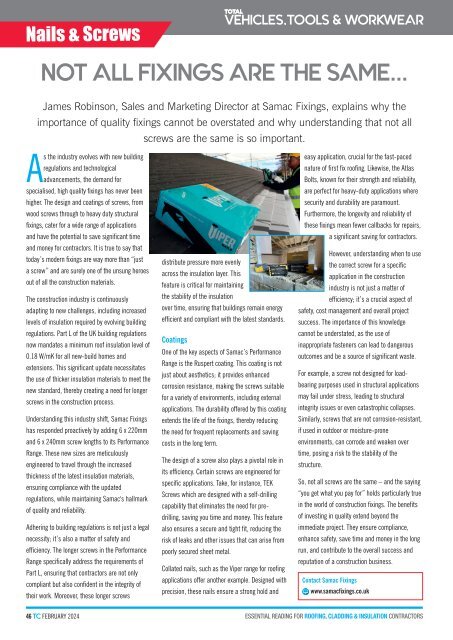February 2024
Create successful ePaper yourself
Turn your PDF publications into a flip-book with our unique Google optimized e-Paper software.
Nails & Screws<br />
NOT ALL FIXINGS ARE THE SAME...<br />
James Robinson, Sales and Marketing Director at Samac Fixings, explains why the<br />
importance of quality fixings cannot be overstated and why understanding that not all<br />
screws are the same is so important.<br />
As the industry evolves with new building<br />
regulations and technological<br />
advancements, the demand for<br />
specialised, high quality fixings has never been<br />
higher. The design and coatings of screws, from<br />
wood screws through to heavy duty structural<br />
fixings, cater for a wide range of applications<br />
and have the potential to save significant time<br />
and money for contractors. It is true to say that<br />
today’s modern fixings are way more than “just<br />
a screw” and are surely one of the unsung heroes<br />
out of all the construction materials.<br />
The construction industry is continuously<br />
adapting to new challenges, including increased<br />
levels of insulation required by evolving building<br />
regulations. Part L of the UK building regulations<br />
now mandates a minimum roof insulation level of<br />
0.18 W/mK for all new-build homes and<br />
extensions. This significant update necessitates<br />
the use of thicker insulation materials to meet the<br />
new standard, thereby creating a need for longer<br />
screws in the construction process.<br />
Understanding this industry shift, Samac Fixings<br />
has responded proactively by adding 6 x 220mm<br />
and 6 x 240mm screw lengths to its Performance<br />
Range. These new sizes are meticulously<br />
engineered to travel through the increased<br />
thickness of the latest insulation materials,<br />
ensuring compliance with the updated<br />
regulations, while maintaining Samac's hallmark<br />
of quality and reliability.<br />
Adhering to building regulations is not just a legal<br />
necessity; it’s also a matter of safety and<br />
efficiency. The longer screws in the Performance<br />
Range specifically address the requirements of<br />
Part L, ensuring that contractors are not only<br />
compliant but also confident in the integrity of<br />
their work. Moreover, these longer screws<br />
distribute pressure more evenly<br />
across the insulation layer. This<br />
feature is critical for maintaining<br />
the stability of the insulation<br />
over time, ensuring that buildings remain energy<br />
efficient and compliant with the latest standards.<br />
Coatings<br />
One of the key aspects of Samac’s Performance<br />
Range is the Ruspert coating. This coating is not<br />
just about aesthetics; it provides enhanced<br />
corrosion resistance, making the screws suitable<br />
for a variety of environments, including external<br />
applications. The durability offered by this coating<br />
extends the life of the fixings, thereby reducing<br />
the need for frequent replacements and saving<br />
costs in the long term.<br />
The design of a screw also plays a pivotal role in<br />
its efficiency. Certain screws are engineered for<br />
specific applications. Take, for instance, TEK<br />
Screws which are designed with a self-drilling<br />
capability that eliminates the need for predrilling,<br />
saving you time and money. This feature<br />
also ensures a secure and tight fit, reducing the<br />
risk of leaks and other issues that can arise from<br />
poorly secured sheet metal.<br />
Collated nails, such as the Viper range for roofing<br />
applications offer another example. Designed with<br />
precision, these nails ensure a strong hold and<br />
easy application, crucial for the fast-paced<br />
nature of first fix roofing. Likewise, the Atlas<br />
Bolts, known for their strength and reliability,<br />
are perfect for heavy-duty applications where<br />
security and durability are paramount.<br />
Furthermore, the longevity and reliability of<br />
these fixings mean fewer callbacks for repairs,<br />
a significant saving for contractors.<br />
However, understanding when to use<br />
the correct screw for a specific<br />
application in the construction<br />
industry is not just a matter of<br />
efficiency; it’s a crucial aspect of<br />
safety, cost management and overall project<br />
success. The importance of this knowledge<br />
cannot be understated, as the use of<br />
inappropriate fasteners can lead to dangerous<br />
outcomes and be a source of significant waste.<br />
For example, a screw not designed for loadbearing<br />
purposes used in structural applications<br />
may fail under stress, leading to structural<br />
integrity issues or even catastrophic collapses.<br />
Similarly, screws that are not corrosion-resistant,<br />
if used in outdoor or moisture-prone<br />
environments, can corrode and weaken over<br />
time, posing a risk to the stability of the<br />
structure.<br />
So, not all screws are the same – and the saying<br />
“you get what you pay for” holds particularly true<br />
in the world of construction fixings. The benefits<br />
of investing in quality extend beyond the<br />
immediate project. They ensure compliance,<br />
enhance safety, save time and money in the long<br />
run, and contribute to the overall success and<br />
reputation of a construction business.<br />
Contact Samac Fixings<br />
www.samacfixings.co.uk<br />
46 TC FEBRUARY <strong>2024</strong>
















